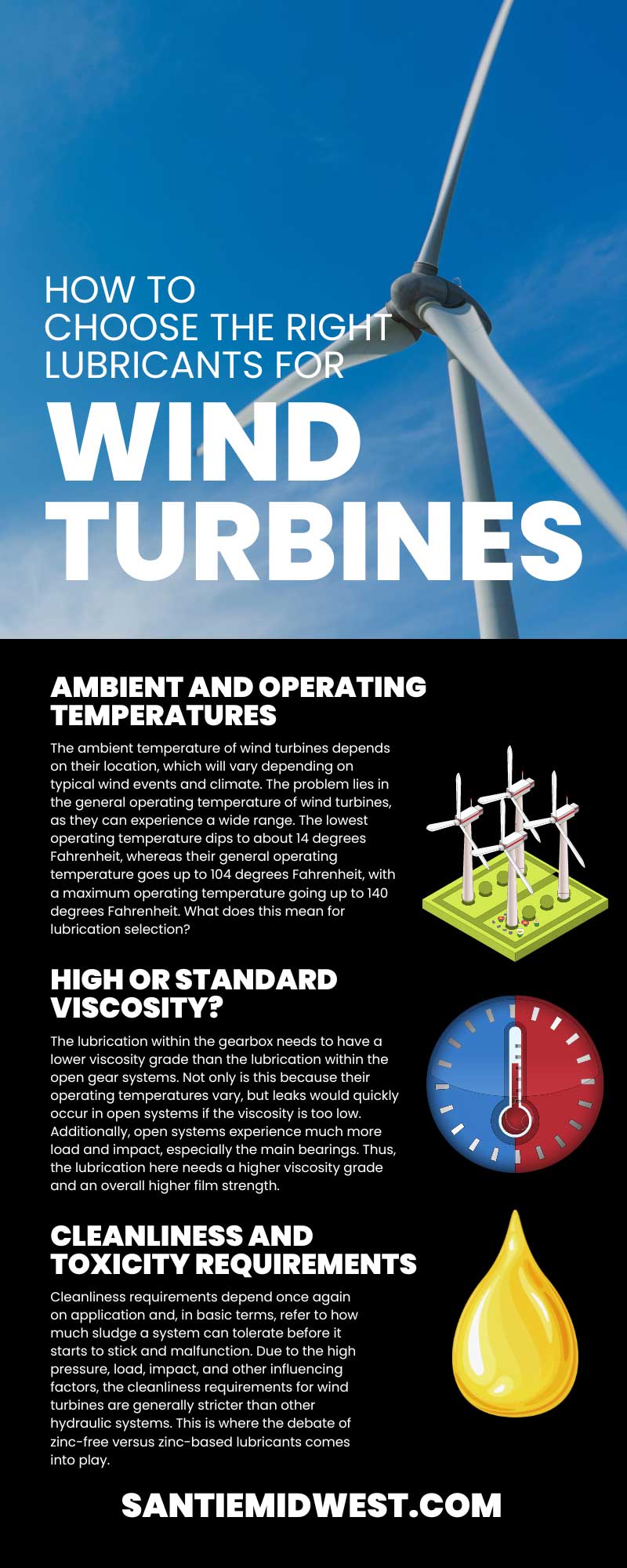Lubricants are a vital element of engines everywhere and come in myriad formulations designed to protect moving parts that exist in various challenging conditions. Wind turbines take months to manufacture and can cost well up into the millions to manufacture and install, and the gear systems themselves cost upward of $100,000. This means that maintaining this machinery and providing it with the proper lubrication is critical to preserving and extending its lifespan. But with how many varying formulations exist, how do you choose the right lubricants for wind turbines?
Ambient and Operating Temperatures
Lubricants need to withstand and remain stable under a range of temperatures. Depending on their application, they must stay within a certain viscosity index during ambient and operating temperatures. When it comes to wind turbines, different lubrication points require different types of lubrication–you wouldn't put the same lubrication in the gearbox as you would on the yaw and pitch bearings. However, these lubrication points will generally experience the same ambient and operating temperatures.
The ambient temperature of wind turbines depends on their location, which will vary depending on typical wind events and climate. The problem lies in the general operating temperature of wind turbines, as they can experience a wide range. The lowest operating temperature dips to about 14 degrees Fahrenheit, whereas their general operating temperature goes up to 104 degrees Fahrenheit, with a maximum operating temperature going up to 140 degrees Fahrenheit. What does this mean for lubrication selection?
High or Standard Viscosity?
While temperature is not the only factor that affects the need for high or standard viscosity, it is one of the most important factors to consider. Standard viscosity lubrication can fail under extreme temperatures, such as what wind turbines experience. This means that wind turbines need a lubricant on the higher end of the viscosity spectrum. However, you also need to take into consideration the varying lubrication points.
The lubrication within the gearbox needs to have a lower viscosity grade than the lubrication within the open gear systems. Not only is this because their operating temperatures vary, but leaks would quickly occur in open systems if the viscosity is too low. Additionally, open systems experience much more load and impact, especially the main bearings. Thus, the lubrication here needs a higher viscosity grade and an overall higher film strength.
Cleanliness and Toxicity Requirements
At the very least, wind turbines need two separate lubricants designed for open systems and closed gearboxes and require lubrication on the higher end of the viscosity index. Now we must look at the lubrication cleanliness requirements and toxicity requirements.
Cleanliness requirements depend once again on application and, in basic terms, refer to how much sludge a system can tolerate before it starts to stick and malfunction. Due to the high pressure, load, impact, and other influencing factors, the cleanliness requirements for wind turbines are generally stricter than other hydraulic systems. This is where the debate of zinc-free versus zinc-based lubricants comes into play.
Most often, the sludge that lubricants form over time is due to Zinc (ZDDP) additives breaking down over time, which is why some prefer lubricants that are zinc free. However, the detergents in zinc-based lubricants mitigate this sludge formation, so how can you choose?
To answer that question, we need to look into toxicity requirements, which will vary based on the wind farm's location. For example, offshore wind farms have strict requirements for lubricants and zinc additives, as zinc-based lubricants are higher in aquatic toxicity. In this case, although it is the more expensive option, zinc-free lubricants are the best option to meet cleanliness and toxicity requirements.
Understanding Additives
Most synthetic lubricants used in the wind energy industry use a base of polyalphaolefin (PAO). However, they require additives which typically get preformulated in the base stock when sold on the market. Below are a few characteristics your wind turbine's lubricant needs that combining the proper additives in the PAO base stock can achieve.
High Flash Point and Low Pour Point
Low pour point is the temperature at which the lubricant loses its flow characteristics and becomes too viscous to flow properly. As mentioned previously, wind turbines experience a wide range of ambient and operating temperatures, and different lubrication points need particular lubricant viscosities. However, additives must get included to keep those viscosities stable at extreme temperatures. These additives are known as pour point depressants. The most common pour point depressants on the market are alkyl aromatics and aliphatic polymers.
Additionally, because wind turbines can experience operating temperatures up to 140 degrees Fahrenheit, additives are necessary to achieve a high flash point. The flash point is the lowest temperature at which the lubricant gives off vapors capable of igniting—the higher the flash point, the lower the fire hazard. Typically, a dialkyl polysiloxane gets added to the formulation to raise the flash point.
Friction Modifiers
Friction modifiers get added to lubricants to reduce the wear and tear on components by minimizing surface contact, which wind turbine gear systems experience in extreme amounts. There are a few different classes of friction modifies. Chemically functionalized polymers and organic friction modifiers are the most commonly used as they are the most efficient.
Anti-Corrosion
Anti-corrosion additives, also called corrosion inhibitors, reduce corrosion and rust by neutralizing acids and forming a chemical barrier that keeps moisture at bay. Sulfonates and fatty amides are the most common corrosion inhibitors and also act as a detergent in zinc-based lubricants to avoid sludge buildup.
Thermal-Oxidative Stability
As oil comes into contact with oxygen, over time, the toughness and stability of the lubricant can begin to degrade, and the degradation process is further accelerated by water and high temperatures. There are quite a few classes of antioxidants used to improve stability. Zinc dithiophosphates and sulfurized phenols are two of the most common lubricant antioxidants available.
To choose the right lubricants for wind turbines, you must consider viscosity needs, clean performance and toxicity requirements, and the necessary performance additives. Fortunately, regardless of what lubricants you choose, Santie Oil Company sells a variety of lubricants for wind turbines so that we can be your one-stop shop for all your oil and grease needs.


